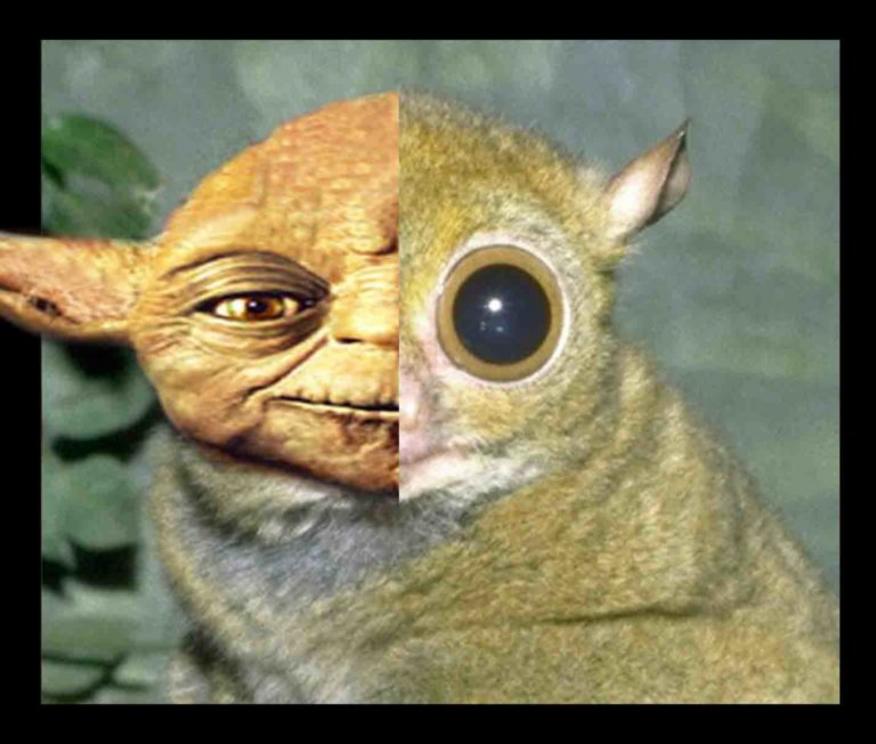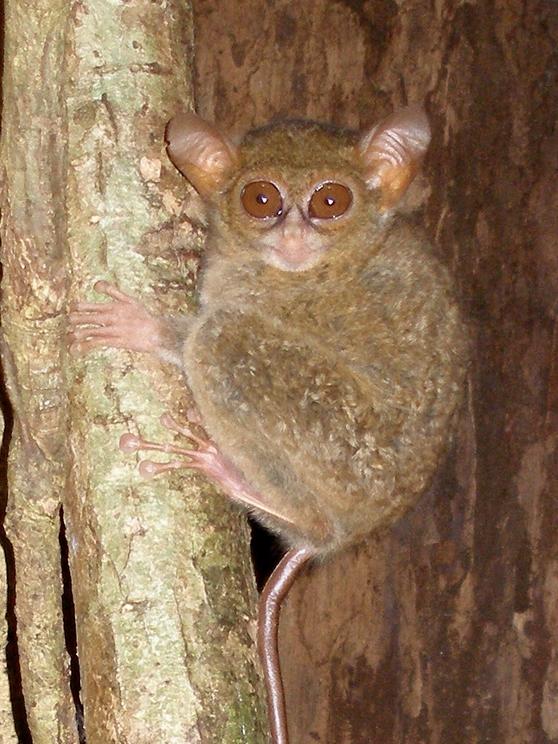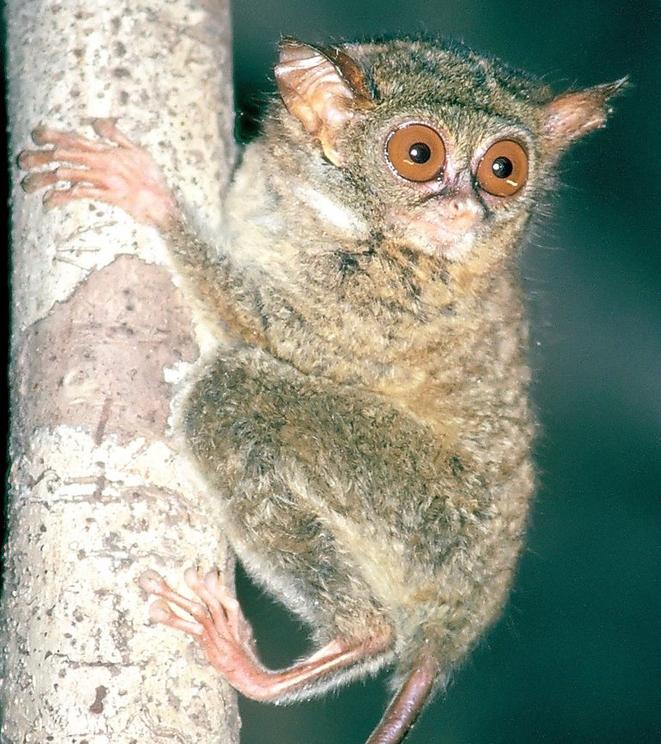Tarsier: two new species of primate discovered
On Star Wars Day comes the announcement of the discovery of two new species of tarsier, the diminutive but surprisingly capable primates rumored to have been the inspiration for Jedi Master Yoda.
“Size matters not. Look at me. Judge me by my size, do you? Hmm? No. And well you should not,” Yoda once famously said. He certainly could have been speaking for tarsiers, as well, with this pronouncement.
Nocturnal creatures that weigh in at a maximum of about 120 grams (or 4.3 ounces) when fully grown, tarsiers can nevertheless easily leap three meters (about 10 feet) or more in a single bound thanks to their super-elongated legs — the longest legs relative to arm length of any primate species.
Tarsiers, found only on a handful of islands in Southeast Asia, use their extraordinary jumping ability to target prey with laser-like precision. As the only purely carnivorous primate on Earth, the tarsier diet consists largely of insects and lizards.

Tarsier-Yoda. Composite image courtesty of Myron Shekelle.
In order to spot their next meal in the darkness of night, tarsiers have developed the largest eyes relative to body size of any known mammal, a crucial adaptation that grants them better night vision even in the absence of the reflective eyeball tissue that most nocturnal species have (think of the spooky glowing eyes of raccoons or cats). Tarsiers’ eyes are so large, in fact, that the creatures can’t even move them around — a limitation they adapted to by developing the ability to swivel their heads 180-degrees in either direction, like an owl.
The two new species, described in an article published in the journal Primate Conservation today, were found on the northern peninsula of Sulawesi, an Indonesian island. With these new members of the tarsier family, there are now 11 species known to reside on Sulawesi and nearby islands.
The species were given the names Tarsius spectrumgurskyae and Tarsius supriatnai in honor of two scientists who have played central roles in conservation efforts in Indonesia — you might even say they are something like Jedi Masters of Indonesian conservation. Dr. Sharon Gursky, a professor of anthropology at Texas A&M University in the United States, has studied her namesake species in Sulawesi’s Tangkoko National Park for a quarter century and is widely recognized as one of the world’s foremost experts on tarsier behavior. And Dr. Jatna Supriatna, a professor of biology at the University of Indonesia, has sponsored much conservation science research in Indonesia and served as director of Conservation International’s operations in the country for 15 years.
As recently as the 1990s, there were believed to be just one or two species of tarsiers in the forests of Sulawesi. Myron Shekelle, a professor of anthropology at Western Washington University in Bellingham, WA and the lead author of the paper describing the two new species to science, has spent the past 23 years helping to show that tarsiers actually represent a cluster of as many as 16 or more species. He led a team of researchers who used the species’ vocalizations and genetic data to establish T. spectrumgurskyae and T. supriatnai as distinct from other tarsiers.
“As with many nocturnal species, they look quite similar,” Shekelle told Mongabay, explaining why tarsier taxonomy was ripe for revision when he first began his work. “So visually-oriented diurnal human taxonomists ‘look’ for differences among species and don’t ‘see’ them. Thus, studies of museum specimens, which were conducted by competent and highly qualified taxonomists, tended not to pick up the differences.”
Field biologists first began to notice differences in the bioacoustics of populations of nocturnal organisms like frogs, crickets, and grasshoppers in the 1950s, Shekelle says. “This led to the theory that these populations were actually a cluster of related ‘cryptic’ species. That is to say, they were taxonomically cryptic, meaning that taxonomists had overlooked the true diversity among many (mostly nocturnal) animals.”

Tarsius spectrumgurskyae. Photo by Myron Shekelle.
In other words, nocturnal creatures may not typically look that much different from their closest relatives, but they often sound different. And new technologies, first deployed in the early 1990s, have allowed us to test the predictions made by scientists back in the 1950s based on their observations of bioacoustics by collecting and comparing genetic data from populations of wild animals.
“Painting with a broad brush, the genetic evidence typically provides robust support for these hypotheses, and in many cases show the splits between the cryptic species to be far deeper than had been imagined,” Shekelle said. “For example, with T. spectrumgurskyae and T. supriatnai, genetic evidence indicates a split of 300,000 years.”
Shekelle notes that much of this history about the tarsiers of Sulawesi was first laid out by researchers in the 1980s, who also provided evidence that there were pronounced bioacoustic differences between the two populations that have now been named T. spectrumgurskyae and T. supriatnai. “I do not want to minimize our work and the responsibility that comes with it, but the simple facts are that much of the basic research supporting these two species came not from recent research conducted by us, but by previous research conducted by others,” he said. “What the current authorship team did was put all of the ingredients into the oven and bake the final cake.”
Tarsiers’ preferred habitat appears to be primary forest, late succession secondary forest, and perhaps the edge between those two forest types, according to Shekelle. But they’re facing a number of threats: “Tarsiers are fairly abundant in nature, except where agricultural poisons are used, where all potential sleeping sites have been stripped away, and where human habitation makes life impractical for them.”
Previous research Shekelle took part in showed that both new tarsier species would likely qualify as Vulnerable based on IUCN Red List of Threatened Species criteria. “But what their ultimate status is is really up to the Indonesians,” he added. “The benchmark for IUCN threat assessments is three generations, which in the case of tarsiers is estimated to be 20-21 years. If habitat destruction over the past 20 years, or if projected habitat destruction over the next 20 years, is estimated to be 50 percent or greater, then the threat status of these [species] will most likely be Endangered, given the other factors involved.”
The two new species of tarsier from Sulawesi are the 80th and 81st new primates described to science since the turn of the century, according to Russ Mittermeier. “This represents about 16 percent of all primate species known, and is indicative of how little we know of our planet’s unique and wonderful biodiversity,” he told Mongabay. Mittermeier is a founder and executive vice-chair of Conservation International who also serves as chair of the IUCN/SSC’s Primate Specialist Group.
“If we haven’t even gotten a handle on the diversity our closest living relatives, which by comparison are relatively well-studied, imagine how much we still have to learn about the rest of life on Earth,” he added.

Tarsius supriatnai. Photo by Lynn Clayton.

